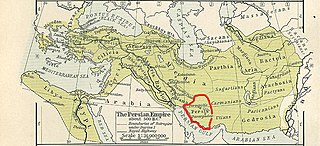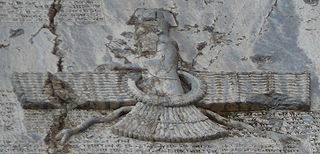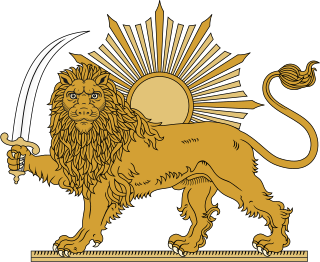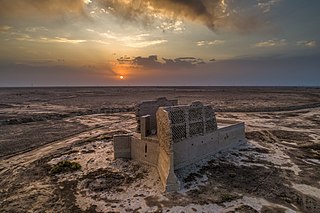Persia , or Iran, is a country in Western Asia.
Contents
Persia or Persias, may also refer to:
Persia , or Iran, is a country in Western Asia.
Persia or Persias, may also refer to:
The Persians are an Iranian ethnic group who comprise over half of the population of Iran. They share a common cultural system and are native speakers of the Persian language as well as of the languages that are closely related to Persian.

The history of Iran is intertwined with Greater Iran, a sociocultural region spanning from Anatolia to the Indus River and from the Caucasus to the Persian Gulf. Central to this area is modern-day Iran, which covers the bulk of the Iranian plateau.

Shahre Ray, Shahr-e Ray, Shahre Rey, or Shahr-e Rey or simply Ray or Rey (ری), is the capital of Rey County in Tehran Province, Iran. Formerly a distinct city, it has now been absorbed into the metropolitan area of Greater Tehran as the 20th district of municipal Tehran, the capital city of the country.

Persis, also called Persia proper, is a historic region in southwestern Iran, roughly corresponding with Fars province. The Persians are thought to have initially migrated either from Central Asia or, more probably, from the north through the Caucasus. They would then have migrated to the current region of Persis in the early 1st millennium BC. The country name Persia was derived directly from the Old Persian Parsa.

King of Kings was a ruling title employed primarily by monarchs based in the Middle East and the Indian subcontinent. Commonly associated with Iran, especially the Achaemenid and Sasanian Empires, the title was originally introduced during the Middle Assyrian Empire by king Tukulti-Ninurta I and was subsequently used in a number of different kingdoms and empires, including the aforementioned Persia, various Hellenic kingdoms, India, Armenia, Georgia, and Ethiopia.

The Kiani Crown was the traditional coronation crown in the Iranian Crown Jewels, worn by the Qajar shahs of Iran (1789–1925). The crown was designed under the first Qajar shah Agha Mohammad Khan Qajar as a way to connect himself to the ancient Sasanian shahs (224–651) and mythological Kiyani shahs.

Greater Iran or Greater Persia, also called the Iranosphere or the Persosphere, is an expression that denotes a wide socio-cultural region comprising parts of West Asia, the Caucasus, Central Asia, South Asia, and East Asia —all of which have been affected, to some degree, by the Iranian peoples and the Iranian languages.
The military history of Iran has been relatively well-documented, with thousands of years' worth of recorded history. Largely credited to its historically unchanged geographical and geopolitical condition, the modern-day Islamic Republic of Iran has had a long and checkered military culture and history; ranging from triumphant and unchallenged ancient military supremacy, affording effective superpower status for its time; to a series of near-catastrophic defeats, most notably including the ancient Greek kingdom of Macedon as well as the Asiatic nomadic tribes at the northeastern boundary of the lands traditionally home to the Iranian peoples.

Zoroastrianism is considered to be the oldest religion still practiced in Iran. It is an Iranian religion that emerged around the 2nd millennium BCE, spreading through the Iranian plateau and eventually gaining official status under the Achaemenid Empire in the 6th century BCE. It remained the Iranian state religion until the 7th century CE, when the Arab conquest of Persia resulted in the fall of the Sasanian Empire to the nascent Rashidun Caliphate. Over time, the persecution of Zoroastrians led to them becoming a religious minority amidst the Islamization of Iran, as many fled east to take refuge in India. Some of Zoroastrianism's holiest sites are located in Iran, such as Yazd.

Iranian nationalism is nationalism among the people of Iran and individuals whose national identity is Iranian. Iranian nationalism consists of political and social movements and sentiments prompted by a love for Iranian culture, Iranian languages and history, and a sense of pride in Iran and Iranian people. While national consciousness in Iran can be traced back centuries, nationalism has been a predominant determinant of Iranian attitudes mainly since the 20th century.

Traditional Persian clothing is the historical costume of the Persian people, and of ancient Persia before the 1930s Pahlavi dynasty. Historically, the fabric and color of clothing was very important. During the Achaemenian period, Persian clothing started to reflect social status and eminence, the climate of the region, and the season. The design philosophy for ancient clothing was a marriage of both function and aesthetics.

The Lion and Sun is one of the main emblems of Iran (Persia), and was an element in Iran's national flag until the 1979 revolution and is still commonly used by nationalists and opposition groups of the Islamic Republic government. The motif, which illustrates ancient and modern Iranian traditions, became a popular symbol in Iran in the 12th century. The lion and sun symbol is based largely on astronomical and astrological configurations: the ancient sign of the sun in the house of Leo, which itself is traced back to Babylonian astrology and Near Eastern traditions.
Iran (Persia) has had numerous capital cities and royal centers throughout its history.

Sistān, also known as Sakastān and Sijistan, is a historical region in present-day south-western Afghanistan, south-eastern Iran and extending across the borders of south-western Pakistan. Mostly corresponding to the then Achaemenid region of Drangiana and extending southwards of the Helmand River not far off from the city of Alexandria in Arachosia. Largely desert, the region is bisected by the Helmand River, the largest river in Afghanistan, which empties into the Hamun Lake that forms part of the border between Iran and Afghanistan.

In Modern Persian, the word Īrān (ایران) derives immediately from 3rd-century Middle Persian Ērān (𐭠𐭩𐭫𐭠𐭭), initially meaning "of the Aryans" before acquiring a geographical connotation as a reference to the lands inhabited by the Aryans. In both the geographic and demonymic senses, Ērān is distinguished from the antonymic Anērān, literally meaning "non-Iran".
This is a list of kings of Iran of the medieval Islamic period, AD 820 to 1432, arranged genealogically.

Persian art or Iranian art has one of the richest art heritages in world history and has been strong in many media including architecture, painting, weaving, pottery, calligraphy, metalworking and sculpture. At different times, influences from the art of neighbouring civilizations have been very important, and latterly Persian art gave and received major influences as part of the wider styles of Islamic art. This article covers the art of Persia up to 1925, and the end of the Qajar dynasty; for later art see Iranian modern and contemporary art, and for traditional crafts see arts of Iran. Rock art in Iran is its most ancient surviving art. Iranian architecture is covered at that article.
The Persian Empire, or Achaemenid Empire, was an Iranian empire founded by Cyrus the Great of the Achaemenid dynasty in 550 BC.